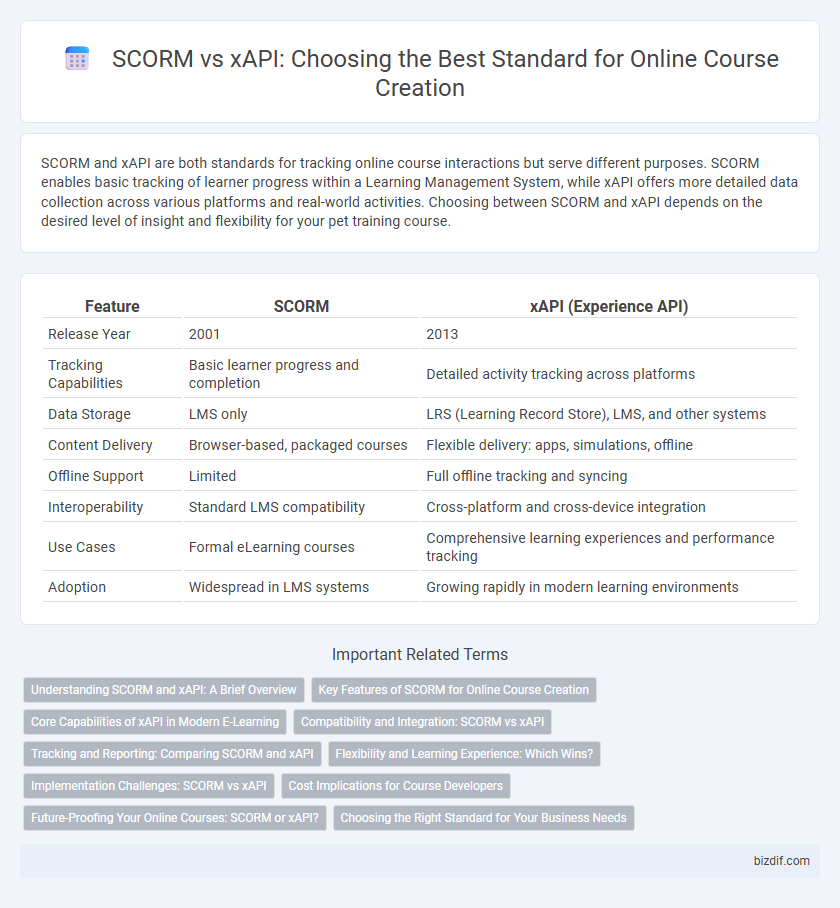SCORM and xAPI are both standards for tracking online course interactions but serve different purposes. SCORM enables basic tracking of learner progress within a Learning Management System, while xAPI offers more detailed data collection across various platforms and real-world activities. Choosing between SCORM and xAPI depends on the desired level of insight and flexibility for your pet training course.
Table of Comparison
| Feature | SCORM | xAPI (Experience API) |
|---|---|---|
| Release Year | 2001 | 2013 |
| Tracking Capabilities | Basic learner progress and completion | Detailed activity tracking across platforms |
| Data Storage | LMS only | LRS (Learning Record Store), LMS, and other systems |
| Content Delivery | Browser-based, packaged courses | Flexible delivery: apps, simulations, offline |
| Offline Support | Limited | Full offline tracking and syncing |
| Interoperability | Standard LMS compatibility | Cross-platform and cross-device integration |
| Use Cases | Formal eLearning courses | Comprehensive learning experiences and performance tracking |
| Adoption | Widespread in LMS systems | Growing rapidly in modern learning environments |
Understanding SCORM and xAPI: A Brief Overview
SCORM (Sharable Content Object Reference Model) is a widely adopted e-learning standard that ensures content compatibility across Learning Management Systems (LMS) by tracking learner progress and completion. xAPI (Experience API), also known as Tin Can API, extends tracking capabilities beyond traditional LMS environments, capturing detailed learning experiences from mobile apps, simulations, and real-world activities. Understanding SCORM's focus on interoperability and xAPI's emphasis on comprehensive data collection is essential for designing effective, future-proof online courses.
Key Features of SCORM for Online Course Creation
SCORM (Sharable Content Object Reference Model) enables seamless integration and tracking of e-learning content across compatible Learning Management Systems (LMS), ensuring standardized communication between course materials and LMS platforms. It supports content packaging, course sequencing, and user progress tracking, allowing developers to create modular and reusable learning objects. SCORM's widespread adoption guarantees interoperability, easing deployment and consistency in online course creation.
Core Capabilities of xAPI in Modern E-Learning
xAPI enables detailed tracking of diverse learning experiences across multiple platforms, capturing data beyond traditional LMS boundaries. It supports offline learning activities, real-time data reporting, and interoperability with various devices and content types. These core capabilities make xAPI a superior choice for modern e-learning environments seeking comprehensive learner analytics and adaptive learning pathways.
Compatibility and Integration: SCORM vs xAPI
SCORM offers broad compatibility with most Learning Management Systems (LMS) due to its long-standing industry adoption, ensuring seamless integration for tracking learner progress. xAPI, however, extends beyond traditional LMS boundaries, allowing data capture from various platforms and learning experiences, enhancing interoperability and detailed analytics. While SCORM is limited to browser-based content, xAPI supports mobile apps, simulations, and offline activities, fostering a more flexible and comprehensive integration ecosystem.
Tracking and Reporting: Comparing SCORM and xAPI
SCORM primarily tracks basic learner interactions within a Learning Management System (LMS), such as course completion, pass/fail status, and time spent, providing standardized reporting across compliant platforms. xAPI enables detailed tracking of diverse learning experiences beyond the LMS, including mobile, offline, and social learning, capturing granular data like specific activities, scores, and learner behavior in real-time. Reporting with xAPI is more flexible and comprehensive due to its ability to aggregate data from multiple sources, offering deeper insights into learning effectiveness and engagement.
Flexibility and Learning Experience: Which Wins?
SCORM offers standardized tracking and compatibility across most LMS platforms but limits flexibility in capturing diverse learning experiences outside traditional modules. xAPI provides enhanced flexibility by enabling detailed tracking of informal, mobile, and offline learning activities, creating a richer, personalized learning experience. For course creators prioritizing adaptive learning paths and comprehensive data insights, xAPI clearly outperforms SCORM in delivering a superior learning experience.
Implementation Challenges: SCORM vs xAPI
Implementing SCORM often presents challenges such as limited data tracking, browser compatibility issues, and dependence on a Learning Management System (LMS) supporting the standard. xAPI implementation requires more complex setup, including backend infrastructure to capture detailed learner experiences and potential integration with multiple platforms beyond traditional LMS. Organizations must weigh SCORM's simpler deployment against xAPI's advanced data capabilities and increased technical demands.
Cost Implications for Course Developers
SCORM courses typically incur lower initial development costs due to widespread compatibility with existing Learning Management Systems (LMS) and standardized content packaging, reducing the need for custom integration. xAPI implementation often demands higher investment in specialized development and LMS infrastructure but offers long-term savings through detailed tracking and interoperability across platforms. Course developers must weigh upfront expenses against extended analytical capabilities when choosing between SCORM and xAPI standards.
Future-Proofing Your Online Courses: SCORM or xAPI?
SCORM remains widely supported for tracking basic learner interactions, but xAPI offers advanced data capture and interoperability across platforms, making it a superior choice for future-proofing online courses. xAPI's ability to record detailed learning experiences beyond traditional LMS environments allows creators to analyze and optimize training effectiveness in real-time. Investing in xAPI ensures scalability and integration with emerging technologies, supporting evolving educational strategies and learner needs.
Choosing the Right Standard for Your Business Needs
SCORM remains the most widely adopted eLearning standard, offering broad compatibility with Learning Management Systems (LMS) and reliable tracking of course completion and quiz scores. xAPI (Experience API) provides advanced data capturing capabilities, including offline learning activities and detailed learner behavior analytics, ideal for organizations seeking comprehensive insights. Choose SCORM for straightforward, LMS-dependent courses and xAPI when your business requires flexible, in-depth learner performance tracking across multiple platforms and devices.
SCORM vs xAPI Infographic

 bizdif.com
bizdif.com